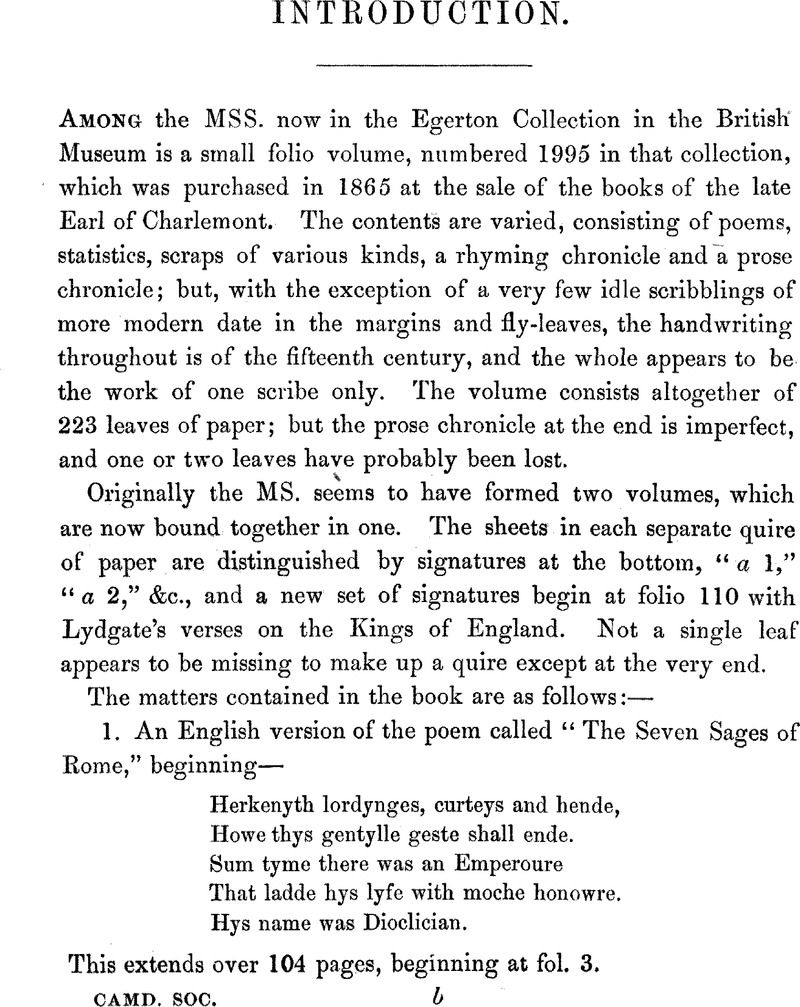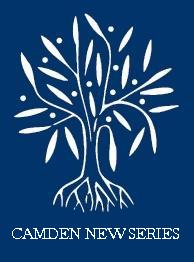No CrossRef data available.
Article contents
Introduction
Published online by Cambridge University Press: 24 December 2009
Abstract

- Type
- Introduction
- Information
- Camden New Series , Volume 17: The Historical Collections of a Citizen of London in the Fifteenth Century , December 1876 , pp. i - xli
- Copyright
- Copyright © Royal Historical Society 1876
References
page vii note a Rymer, xi. 232.
page ix note a It was then near Bishopsgate.
page ix note b There was a blank here in the MS. which has been improperly filled up by the rubricator with, a mark ¶, indicating a new paragraph.
page ix note c St. Thomas's Hospital.
page xii note a M. Puiscux point s out that this “cursed deed,” as the poet calls it (involving as it did the destruction of a number of churches), was dictated by considerations of prudence, the importance of which had been recently illustrated in the case of Caen. The reluctance of the inhabitants to destroy the abbeys of St. Etienne and Ste. Trinité had been the chief cause of the loss of that city.—Siège et Prise de Rouen, 56.
page xvii note a Stowe's Survey, iii. 102.
page xxii note a I have already pointed this out in another publication (Paston Letters, vol. i. Introduction, p. lv.), quoting as my authority a MS. in the Lambeth Library, which Ihop e shortly to edit for the Camden Society.
page xxii note b The story of Jack Cade, however, is attended with difficulties from any point of view, and it is remarkable that when Cade's body was brought to London it was taken to the White Hart at Southwark, where he had lodged before his entry into the City, and identified by the woman who kept the house (p. 194). We hear nothing of its being identified by anyone who had seen the leader before the battle of Sevenoaks.
page xxii note c See page 198, notea.
page xxiv note a Page 203. The Continuator was probably a personal friend of this William Ive, whom he mentions again shortly afterwards with praise for the part he took in a controversy with the Friars. As Ive belonged to Wykeham's College at Winchester, and other matters of local interest are mentioned in this part of the Chronicle, I am inclined to think the Continuator must have been a Hampshire man.
page xxiv note b Page 204.
page xxv note a Page 212.
page xxvi note a Hall's Chronicle. Whethamstede. Rolls of Parliament, v. 476.
page xxvi note b Pages 212—214. Whethamstede, i. 391. (Rolls ed.)
page xxvii note a Page 219.
page xxvii note b Page 221.
page xxviii note a Proclamation was made on the 27th Oct. 1463, of a trace with France till 1st Oct. 1464. (Close Rolls).
page xxviii note b Sir Ralph Percy swore allegiance to Edward at the same time as Somerset, and they agreed to deliver up Bamborough and Dunstanborough Castles on condition that Percy should have the keeping of them. He abused his trust, and let the French gain possession of Bamborough (pp. 219, 220.) Sir Ralph Grey, also, who was made Constable of Alnwick, under the gallant Sir John Ashley, betrayed his Captain to the enemy (p. 220), a deed for which he was afterwards condemned to death and beheaded, his spurs being first struck off by the hand of the Master Cook. (MS. in Heralds' College, quoted in Notes to Warkworth's Chronicle, p. 39). Yet through all this treachery there seems to hate been, with some at least, a strange peryerted notion of honour. Percy was slain at Hedgley Moor, where he refused to fly as others did, exclaiming as it is said, “I have saved the bird in my bosom.” By this he meant that he hadpreserved his loyalty to Henry VI., forgetting that he had actually sworn allegiance to Edward IV. The place where he fell is called Percy's Cross to this day, and is marked by an octagonal pillar. (Holinshed, iii. 666. Pennant's Tour in Scotland, iii. 288.)
page xxix note a Pages 223–4.
page xxix note b The Year Book in Easter, 4 Edw. IV. says that Tailboys (there called the Earl of Kyme) was taken in Riddesdale.
page xxix note c Page 226.
page xxix note d Rolls of Parliament, v. 181, 200.
page xxix note e See Lord Wenlock's letter on the subject, dated Reading, 3rd Oct. 1464, in Wavrin (Dupont's ed.), ii. 326–7.
page xxx note a See two valuable notes in Kirk—s “Charles the Bold,” i. 415, and ii. 15.)
page xxx note b See a paper printed in Wavrin, iii. 183.
page xxxi note a Alnwick surrendered at once on the 23rd June as soon as Warwick came before it. Dunstanborough probably surrendered also the same day, as Warwick “kept the feast of St. John the Baptist” (24th June) there. See MS. in Heralds' College, quoted in Notes to Warkworth's Chronicle, p. 37.
page xxxi note b Fabyan.
page xxxi note c Page 227. Grey's degradation from knighthood, mentioned in a previous note, took place, according to the Year Book, “devant mults del people le Roys. ses gilt spores hewes de ses pees, et son espee et tout son armour sur luy debruse et pris de luy en le champe, et puis il decoll.” This punishment was inflicted on him about (enter) St. Benet's day (11th July) on account of “son perjury et doubleness que il avoit fait al Roy Henry le Size jadis Eoy, &c, et auxy al Roy Edward le Quart que ore est.”
page xxxi note d Page 227.
page xxxii note a Page 228.
page xxxii note b Warkworth says he was taken “bysyde a howse of religione in Lancashire..…in a wode called Cletherwode beside Bungerly Hyppyngstones.” This last-named locality is explained by the late Mr. Nichols to have been a ford with stepping-stones across the Eiver Kibble. Henry, however, eluded his captors (at least so I understand Warkworth to imply) and was afterwards retaken, being surprised at dinner at Waddington Hall, in Yorkshire, not many miles off. All this is quite consistent with his having been first recognised in Furness Fells, from which district he might have been pursued to the neighbourhood of Clitheroe. If it be true that he took refuge at Bracewell and Bolton as well as at Waddington (see Mr. Nichols's note to Warkworth, pp. 42–3) it was probably after his flight from Clitheroe.
page xxxiii note a Pages 235–6.
page xxxiii note a W. Wyrc, 511, 514.
page xxxvi note a W. Wyrc, 515.
page xxxvi note b Fabyan. Orridge's Illustrations of Jack Cade's Rebellion, pp. 12, 13.
page xxxvii note c Foss.
page xxxv note a Fortescue de Laudibus Legum Angliæ, ed. Amos, p. 71. Although Fortescue does not mention the name either of the knight or of the criminal there can hardly be much doubt that this was the case referred to. In fact, as an acute critic pointed out in the last century (see Biog. Brit., art. “Fortescue,” p. 1992, footnote), a case so alluded to must have been notorious, and the circumstances as related in Fabyan's Chronicle exactly correspond with the way in which Fortescue speaks of them. The notoriety of the case is further shown by the reference made to it in the speech of the Duke of Buckingham before the accession of Richard III.: “What need I to speak of Sir Thomas Cooke, alderman and mayor of this noble city? Who is of you, either of negligence that wotteth not, or so forgetful that he remembreth not, or so hardhearted that he pitieth not, that worshipful man's loss,—what speak I of loss?—his wonderful spoil and undeserved destruction,—only because it happened him to favour them, whom the prince favoured not?” (Hall's Chronicle, p. 369.) Mr. Orridge has quoted this passage from Holinshed in his notices of Malpas and Cooke in connection with Cade's Rebellion.
page xxxvi note a Page 238.
page xxxvii note a Pages 222–3.
page xxxix note a Pages 228–232.
page xl note a Pages 233–4.
page xl note b Pages 234–5.
page xli note a Page 238.


